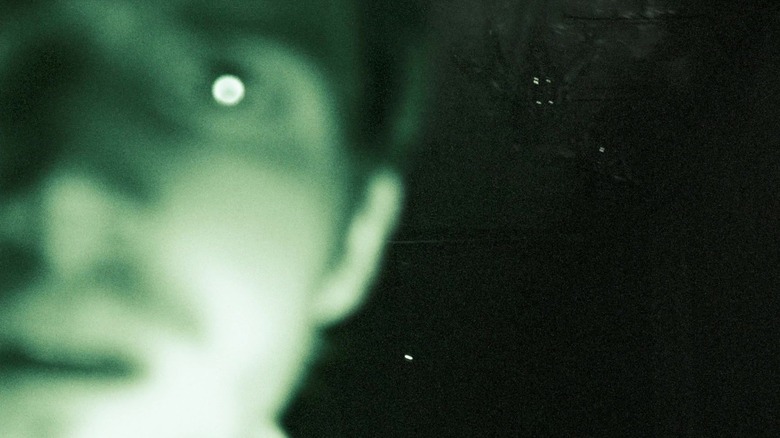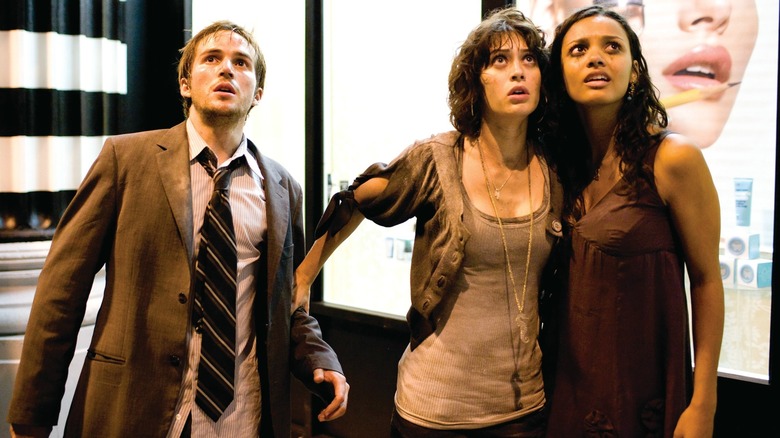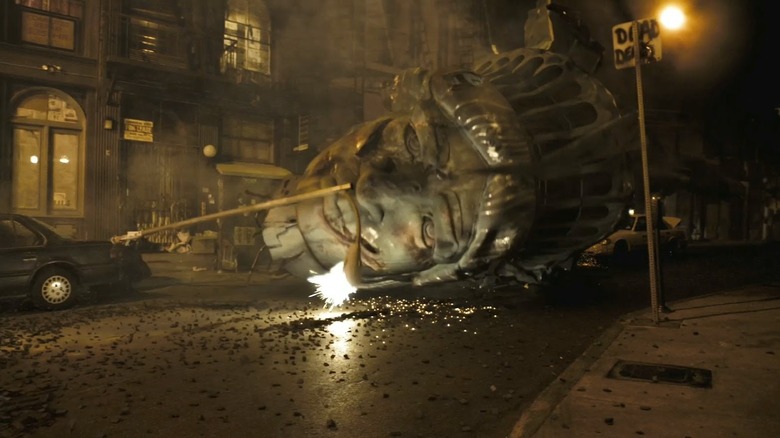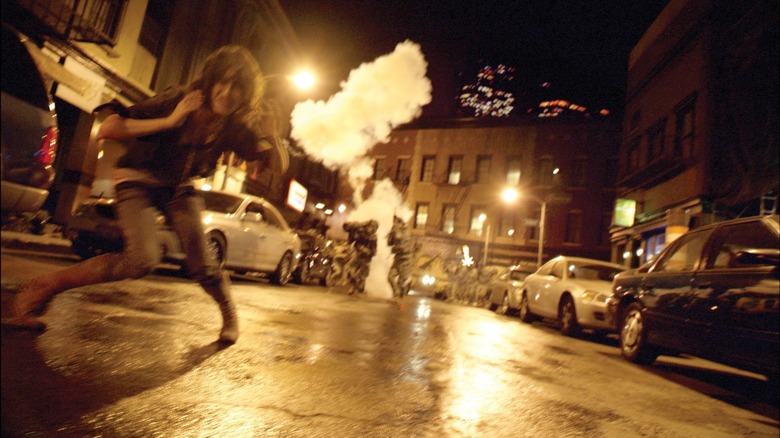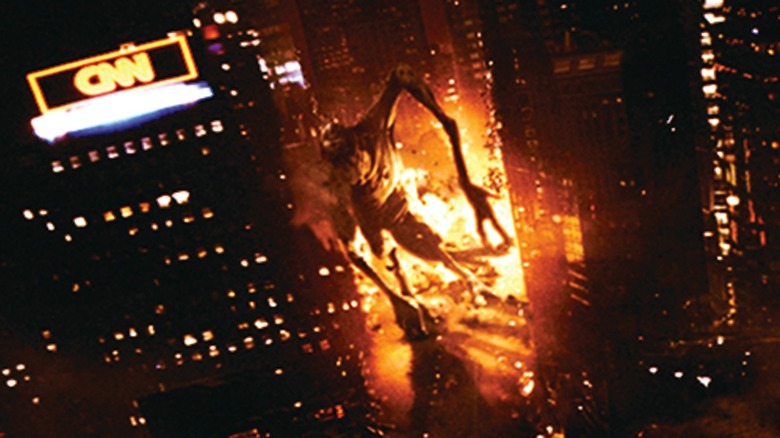Tales From The Box Office: 15 Years Ago, Cloverfield Became A Monster-Sized Found Footage Hit
(Welcome to Tales from the Box Office, our column that examines box office miracles, disasters, and everything in between, as well as what we can learn from them.)
Found footage was, it's easy to forget, a pretty major revolution in popular cinema. With roots dating back to "Cannibal Holocaust" in 1980, the form went mainstream with "The Blair Witch Project" in 1999. The film became an unexpectedly huge hit with its low-tech approach and ultra-tiny budget, and the subgenre absolutely exploded in the 2000s. This was, in part, because the movies could be made very cheaply and, secondly, because audiences were eating this stuff up. "Paranormal Activity" still ranks as the most profitable film of all time. The found footage boom was a huge, huge deal.
But, nearly a decade into the craze, the time for reinvention was upon us. Using the low-budget, supernatural horror approach can only take one so far. Enter J.J. Abrams, Matt Reeves, and Drew Goddard, a trio of filmmakers relatively early on in their big studio movie days who would ask the question: "what if found footage, but expensive?" The result was "Cloverfield," a crowd-pleasing, wildly inventive monster movie that took the found footage craze and put it on the largest stage possible. The results were remarkable for a number of reasons.
In honor of the movie's 15th anniversary, we're looking back at "Cloverfield," how it came to be, how Paramount unleashed a genius marketing campaign for the ages, how that helped turn it into a massive hit, and what lessons we can learn from it in the modern context. Let's dig in, shall we?
The movie: Cloverfield
It's important to understand where these filmmakers were at in 2007 when this movie was coming together. J.J. Abrams was coming off of his successful feature directorial debut, "Mission: Impossible III," after having worked for years on successful TV shows such as "Alias" and "Felicity." Meanwhile, his pal and collaborator Matt Reeves, who would go on to helm massive blockbusters such as "Dawn of the Planet of the Apes" and "The Batman," was going to get his chance to step up to the big leagues with "Cloverfield." Finally, there's screenwriter Drew Goddard, who, before writing movies like "Cabin in the Woods" and "The Martian," had written episodes of "Buffy the Vampire Slayer" and "Alias."
The point being, they weren't the titans of the industry that they're viewed as today, though Abrams was arguably on his way, having been tasked with directing "Star Trek" around the same time this movie was coming together. As for the idea? Touching on that at San Diego Comic-Con in 2007, Abrams explained that it sparked during a visit to Japan.
"I was in Japan over a year ago with my son who is eight and all he wanted to do was go to toy stores. We went to a store and saw Godzillas everywhere and I thought what better? We need our own monster. We need a monster movie. I love King Kong! King Kong is just adorable and Godzilla is a charming monster. I love Godzilla but I wanted something that was just insane and intense."
Paramount gave the movie the green light in secret in early 2007, with the idea being that nobody would know what the studio or the filmmakers were up to. The secrecy was so intense that the cast members, including Lizzy Caplan, Mike Vogel, Michael Stahl-David, and Jessica Lucas, weren't given any script pages, or virtually any information about the film.
Key influences and marketing brilliance
This veil of secrecy would become a defining part of not only this movie but both "10 Cloverfield Lane" and "The Cloverfield Paradox" as well. Paramount got an early start on the marketing for the film, with a trailer debuting in theaters alongside the release of "Transformers" in the summer of 2007. A genius move, given that Michael Bay's take on the popular Hasbro toys became a giant hit blockbuster, meaning that intriguing teaser trailer got a lot of eyeballs on it.
There was also the teaser poster, which features a beheaded Statue of Liberty with the tagline "Something has found us." We wouldn't find out what found us until opening weekend, but we did find the Statue of Liberty's missing head in that teaser trailer. Turns out, it was a giant monster rampaging around New York City, with the bulk of the movie focused on a group of friends trying to survive the chaos and escape to safety. It was too intriguing to be ignored. Speaking to that image of the missing head in 2007, Reeves explained that it was inspired by a certain John Carpenter sci-fi classic.
"The inspiration came from the poster of 'Escape from New York.' The poster had an image on it of the head of the Statue of Liberty and that image was nowhere in the movie! And it's an incredibly provocative image. And that was the source that inspired [producer] J.J. [Abrams] to say, 'Now this would be an interesting idea for a movie.'"
And so, the stage was set. A teaser trailer for the ages, a poster that raised many eyebrows, and a trio of soon-to-be A-list Hollywood filmmakers, all working within a popular subgenre that was ripe for a fresh take. Checkmate.
The financial journey
Paramount exercised some solid strategy when it came to the release date for "Cloverfield," opting to put it in theaters in January, which has historically been a bit of a dead zone for the box office, with horror being a notable exception. The film was released on January 25, 2008. Rather remarkably, the turnaround was very fast, as filming didn't actually begin until the summer of 2007. The quick work did not, however, result in an inferior product. The monster flick debuted to very solid reviews, which, coupled with clever marketing, made for a winning combination.
With its only competition being "27 Dresses" (all due respect), "Cloverfield" easily took the top spot on its opening weekend with a stellar $40 million debut. Given its reported $30 million budget and seemingly thrifty marketing campaign, that was a ridiculously great number. Granted, the movie took a nosedive in its second weekend, dropping nearly 70 percent for a $12.7 million second weekend haul. Though, ultimately, the drop-off didn't matter.
In the end, the film took in $80 million domestically as well as an even better $92.3 million internationally for a grand total of $172.3 million. Or, for you math lovers out there, around 5.7 times its production budget. Couple that with Blu-ray/DVD sales, cable rights, and other revenue streams down the line, and Paramount hit a home run with this one. Found footage could, officially, be more than low-budget horror. It could scale up to blockbuster-level entertainment. Save for some audience members getting sick from the shaky-cam style of filming, things went off without a hitch.
The lessons contained within
Paramount Pictures is not, nor have they ever really been, the biggest studio in Hollywood. Especially in the modern era, they are simply dwarfed in many measures by the likes of Warner Bros. and Disney. Credit where credit is due though, when they get it right, they really get it right. I even considered them to be the overall "winner" of 2022, as far as executing the business of the movie business goes. "Cloverfield" is a crowning achievement that represents what they do best when the stars align.
J.J. Abrams aside, nothing really said "bet on us" with this trio of filmmakers at that time. Especially in this genre, where its hay was made because the films were low-budget. $30 million is a heck of a lot more than the $15,000 it cost to make "Paranormal Activity." But there was some admirable forward-thinking here in realizing that this genre could do more and be bigger. For their faith, they were rewarded with a franchise that continues to this day, with a new entry currently in the works.
And look, I'm no marketing genius, but this marketing campaign is one for the ages. Truly. Easier said than done as far as executing something this well, but the value of a good marketing campaign for a movie simply cannot be overstated, particularly when you're talking about something original. In a day and age when it is damn near impossible to get people to go to the movies for a non-franchised film, marketing campaigns like this one are what studios should strive for more often. Do I mean the secrecy and mystery element? No. But clever, outside the box, and well thought planning goes a long way.
